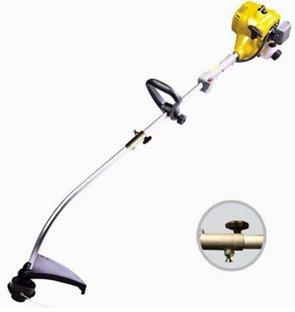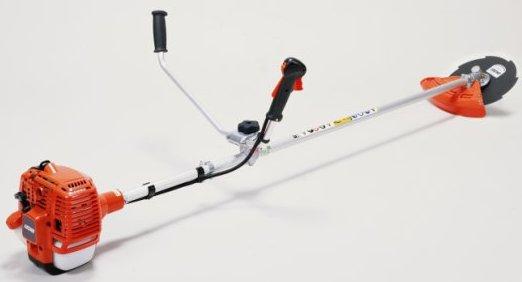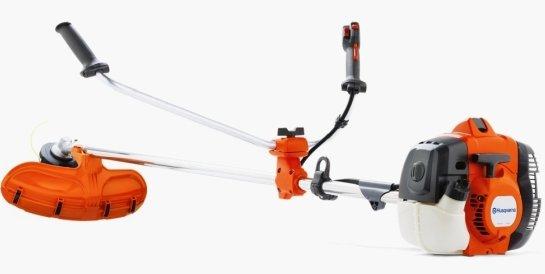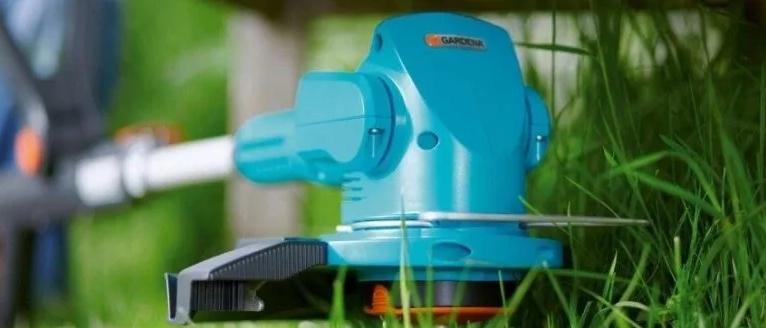The popularity of the American invention for mowing grass - brushcutters, is growing exponentially. The number of land owners is growing. To maintain order and proper appearance on the site, they increasingly use a motorized tool - a brushcutter. In many places in the garden or on a large area, it is not easy to do the job quickly and efficiently by hand. The topic of today's article is how to choose a brushcutter.
Various brands and manufacturers offer a wide variety of trimmer and lawn mower models. It is difficult to choose suitable equipment in terms of quality and cost from the variety of assortments All types of mowers significantly differ in functionality, the material from which the devices are made, and design. The purpose of the article is to acquaint readers with the types of equipment, functionality and operating principles. And, of course, to solve the problem - how to choose a petrol brushcutter, what to look for when buying.
Content
Types of brushcutters

Equipment for mowing grass is divided into 4 main types: household, semi-professional, professional, premium.
Household appliances are the most popular among the population. The tool has enough power to process an average plot of 6-25 acres. A feature of household brushcutters, in contrast to professional equipment, is a curved collapsible bar. This design allows you to conveniently transport and store the device. As a rule, the power of household brushcutters is no more than two horsepower.

Semi-professional brushcutters have improved technical characteristics, more engine power and are in a higher price category. The equipment is used by landscape designers and amateur gardeners.

Professional brushcutters have an increased engine power (over 1.8 horsepower). This allows large areas to be treated over a long period of time. The tools differ from the previous versions: non-separable sealed rods, the type of cutting elements, the presence of forged shafts inside the rods, high-quality gearboxes. In addition to a cutting element with a thick line, the professional gas trimmer kit contains replaceable steel blades. The performance, reliability and cost of such a tool are much higher than household braids.

The premium tool has a high level of performance, low gasoline and oil consumption. These brushcutters are ideal for harvesting large amounts of hay on farms.
By the type of motor, garden tools are divided into 3 types: electric, gasoline, battery mowers. The power of the electric trimmer is significantly less than that of a unit with a gasoline engine. The use of an electric mower is limited due to the need for a power supply. Mostly household tools are equipped with this type of engine. The disadvantage of such equipment is the prohibition on mowing wet grass. The plus of the electric device is that there is no need to constantly refuel. Other advantages of the electric trimmer: environmental friendliness, absence of combustion products, reasonable price.

Petrol cutters are powerful and efficient. Fuel consumption depends on the model.The internal combustion engine uses a mixture of oil and gasoline as fuel. Disadvantages of such a tool: high cost, significant weight, periodic refueling (additional costs).
The cordless type of tool is not very powerful. Battery trimmers by time and area of use. The advantages of such a device include: autonomy, low weight, environmental friendliness (no exhaust gases). Usually the weight of the device does not exceed 4 kilograms. The tool is suitable for small areas that do not have a lot of work.
The device of brushcutters and the principle of operation
All devices for mowing grass differ in purpose and functionality. Each model has its own technical characteristics and performance. But most modern brushcutters are structurally similar. The main units of the devices are the following parts: mowing head, bar, handles, motor, cutting elements.
The mowing head performs the function of feeding the cutting element (line). The line is fed after the cutting head touches the ground. In this case, the Tap'N'Go technology is used. This part of the device is divided into 3 types: manual, semi-automatic, automatic head.
The bar in mowers is of several types: collapsible, curved, straight. The first type of bar is used for household appliances. The collapsible rod type is convenient for storage and transportation. Professional and premium mowers have straight, non-separable rods, as they have a cast shaft.
Brushcutter handles are of bicycle type (t / u shape) and d-shape. Household mowers rarely use the first handle type. For a wide grip and at different levels, the t / u shape is suitable. In the D-shape, the handle is held in one hand. And the other hand holds the barbell. This type of handle is ideal for small mowing widths and on one plane.
The motor for brushcutters with a gasoline engine is of two types: four-stroke and two-stroke. The first type of engine has 2 reservoirs - one for oil, the other for gasoline. The second version has one tank for a mixture of gasoline and oil. Monoblock and knapsack brushcutters differ by engine location. The first type of trimmer has a motor on the boom. The second type of motor is placed in a backpack on the back.
Professional brushcutters, in addition to the cutting head with a line, are equipped with steel replaceable knives. Oil and gasoline are mixed in two-stroke engines in a ratio of 1 to 50. For high-speed engines, it is especially important to use high-quality and clean oil. Otherwise, quick wear and engine failure is ensured. Gasoline, too, must be used only of high quality, not lower than the AI-92 brand.
Cutting parts are subdivided into knives, line or disc. Discs and knives are used when mowing grass and bushes over a large area.
The number of petals can be up to 8 pieces. Such a tool copes with a large amount of work, with tall and twisting grass, with branches.
Many tines are used in professional brushcutters. Such units are able to cope with shrubs and branches. The cutting elements are covered with a special protective cover. Line thickness from 2.4 mm is one of the indicators of a professional device. In budget models, fewer teeth and line are often used in inexpensive units that are thinner than in professional braids.
Which brushcutter to choose
For a large volume of work, the performance and power of the unit are of particular importance. For mowing grass in a small garden area, a couple of times a month it is more profitable to buy an inexpensive high-quality model with a two-stroke engine. It is better to choose inexpensive options for brushcutters from trusted manufacturers so that in a few days you do not have to repair a cheap fake. A good option for a small area is the Patriot or Champion.The budget models have up to 2 horsepower, curved booms and d-shaped handles.
The high cost of professional brushcutters is justified by the quality and excellent power. Such units are notable for their reliability in operation and a long service life. The devices are suitable for continuous operation for 2-10 hours. With a large volume of work - more than 15-20 acres, of a complicated degree (tall weaving grass, shrub), it is better to give preference to an instrument with a rigid bar, U-shaped handle and engine power of 2 horsepower. In addition to the fishing line, the powerful unit should include a knife with several blades.
When choosing brushcutters, the following parameters should be taken into account: speed, type of bar, weight, type of cutting parts, shape of the handle, capacity of the fuel tank. The higher the rotational speed, the more gentle the mode is for the grass stalks (for new growth). The straight bar is designed for a large amount of work. When the cutting part strikes a rigid obstacle, the curved rod absorbs well. The collapsible bar is convenient to transport and store. In these cases, the tool does not take up much space.
When purchasing a tool, consider the weight. A brushcutter with an average engine power weighs 5-8 kilograms on average. Some professional devices weigh more than 8 kilograms. Therefore, when choosing, you need to look at the complete set. The brushcutter must come with either a belt or a knapsack (for heavy models).
Cutting elements in brushcutters are represented by: saw blades, knives, cords. Professional scythes are equipped with a saw blade. this option is suitable for cutting very tough stems and branches. Gas cutters equipped with knives are designed for cutting coarse dense grass and thin branches. The number of knives depends on the power of the motor. Cord (fishing line) is used in household tools. The thicker the line, the coarser the grass can be cut. The cord thickness directly depends on the motor power.
Brushcutter selection parameters
As described above, there are several types of brushcutters. A lot of models are produced. It is sometimes difficult to choose a particular instrument. How to choose a brushcutter for the home, and what characteristics to pay special attention to - we will consider in detail. A high-quality and even cut of grass will work better with a gas cutter with a steel knife.
For example, electric or cordless scythes are supplied mostly with plastic blades and line. On an uneven surface, a brushcutter with a small knife, in which both sides of the knife are sharpened, is suitable. For a large volume of work, it is better to choose a petrol cutter with triangular blades or with a disc as a cutting element. You should pay attention to the diameter of the knife - the larger it is, the more productive the scythe.
For a working area larger than the standard, the best solution would be a braid with a non-separable bar. Inside a strong metal rod is an equally strong rigid shaft. The reliability and durability of such a tool is higher than that of trimmers with flexible bars, plastic knives and fishing line. In addition to tall grass, such braids can easily cope with shrubs. Another positive point is tightness.
The service life of the equipment increases significantly due to the absence of dust and dirt in the inner parts of the streamer. The disadvantages include the increased weight and cost of the unit. A tool with a two-stroke motor is suitable for a small area. In addition to light weight and size, money is saved. True, there are disadvantages compared to a four-stroke engine. Increased vibration, exhaust and noise levels.
Which company to choose - the best brushcutter manufacturers
There are a lot of gardening tool manufacturers. The buyer often has difficulty - which brushcutter to choose from a variety of brands and models. There are a number of leading companies in the production of professional and household appliances. The following are the best brands and companies that make brushcutters.
- Stihl.
- Honda.
- Hitachi.
- Makita.
- Energomash.
- Echo.
- Interskol.
- Husqvarna.
- MTD.
- Caiman.
The most popular among buyers are mowers of famous brands: Swedish Husqvarna, Japanese Makita, Hitachi, Honda, Russian Interskol and Energomash
How much does a brushcutter cost
Petrol cutters with a four-stroke engine are quiet and economical. But the cost of a quality tool from popular brands varies from 15 to 45 thousand rubles. The premium tool exceeds this cost.
For example, a professional tool Echo and Husqvarna costs between 19-40 thousand rubles. The average price of budget household petrol cutters with a two-stroke engine is 5-18 thousand rubles. For example, the average price of high-quality household brushcutters Caliber 1200 and Patriot PT 3355 is 6,000 rubles. The minimum average cost of household petrol cutters from Husqvarna is 5 thousand rubles.



